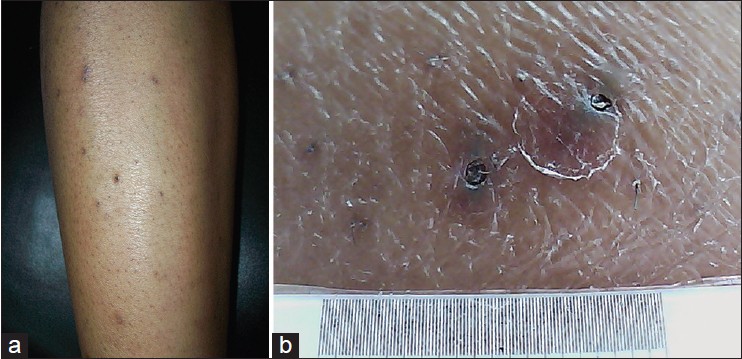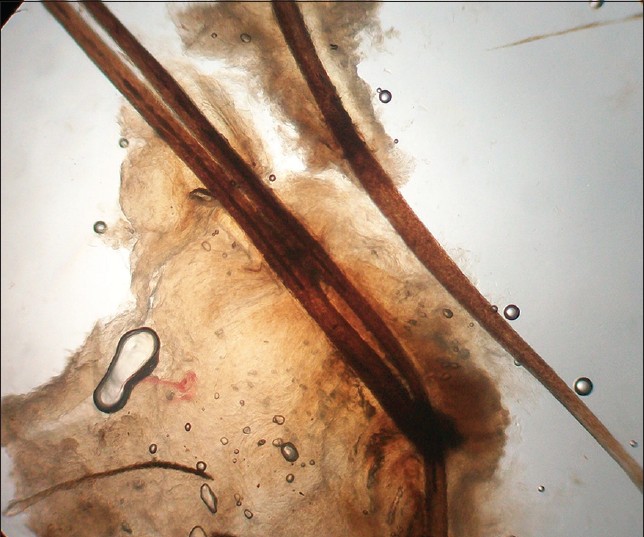Translate this page into:
Secondary comedones after waxing
Correspondence Address:
Jignesh Babulal Vaishnani
Department of Dermatology, Room No -10, Surat Municipal Institute of Medical Education and Research Hospital, Opp. Bombay Market, Umarwada, Surat - 395 010, Gujarat
India
| How to cite this article: Vaishnani JB. Secondary comedones after waxing. Indian J Dermatol Venereol Leprol 2015;81:96 |
Sir,
An 18-year-old woman presented to us with multiple asymptomatic skin lesions on her leg, which were present since six months [Figure - 1]. She used to wax her legs every 4-5 months for the last 3 years using wax she procured from a local manufacturer. There was a history of itching over the waxed areas for a few days after waxing. There was no history of using any medication for her skin condition. Clinical examination revealed multiple non-elevated comedo-like lesions over both the legs. Video dermoscopy revealed 1 to 1.5 mm sized open comedones with keratinous plugs [[Figure - 1]a]. They were manually extracted with a comedone extractor and black greasy keratinous material along with hair was extruded [Figure - 2]. Most of the hair remained in the lesions even after comedone extraction. Microscopic examination of the extracted material revealed 2-3 hairs with keratinous material [Figure - 3].
 |
| Figure 1: (a) Multiple, discrete hyperpigmented lesions on the leg, (b) 1-mm-sized open comedones on dermatoscopy |
 |
| Figure 2: On manual extraction, black greasy material along with hair came out from the lesion |
 |
| Figure 3: Microscopy of the extracted material revealed multiple hairs with keratinous material |
Acne lesions are usually found over the face, chest, and upper back. Comedones at unusual sites have been reported in porokeratotic eccrine osteal and dermal duct nevus, familial dyskeratotic comedones, Darier′s disease, acne mechanica, nevus corniculatus, comedo nevus, solar comedones, neurofibromatosis, [1] follicular mycosis fungoides, [2] and systemic amyloidosis. [3]
This case probably represents a type of acne mechanica. [4] Acne mechanica is a variant of acne where mechanical factors such as pressure, friction, occlusion, heat, squeezing, or stretching precipitate acneform eruptions. The exact mechanism of acne formation is not clear. Comedogenesis is multifactorial and it is possible that mechanical removal of hair leads to inflammation and blockage of the pilosebaceous unit. Trauma to the follicular unit leads to abnormal barrier function of the follicular epithelium, which may enhance follicular bacterial colonization. The inflammation may precipitate abnormal follicular keratinization. Sebaceous secretions and exfoliated keratin remains deposited in the pilosebaceous canal. This leads to comedone formation and new hairs can get stuck in the pilosebaceous canal. Rupture of the follicular epithelium may further aggravate this condition. The number of hair in the comedones depends upon the duration of lesions, as cyclical hair growth and shedding continue in the blocked pilosebaceous canal.
Besides mechanical factors, the content of wax may also play a role in the formation of comedones (acne venenata). Home-made wax usually contains sugar, liquid glucose, honey, lemon juice, etc., while commercially available waxes contain wax base (paraffin or beeswax), resin, lubricants and additional ingredients such as moisturizers, colour, fragrance, fruit extracts, citric acid etc.
James et al. studied the hair in comedones and found that open comedones have a higher number of hair as compared to closed comedones. They also observed that all the hair were of the vellus type and always in telogen phase, with the number of hairs ranging from 2-15. [5] These observations indicate that ingrown hair or trichosis is usually a part of a comedone. It is not visible on naked eye examination and requires microscopic examination. In our case, the hair inside the comedonic material was larger and pigmented, and visible to the naked eye after extraction. Microscopic examination revealed that it was telogen hair.
Ingrown hair, folliculitis, pseudo-folliculitis, and post-inflammatory pigmentary changes after waxing are common side effects of waxing. Eruptive syringomas have also been reported. Our patient had clinical findings suggestive of open comedones with ingrown hair secondary to waxing, and was treated with manual extraction. Comedones on the leg following waxing are unusual and rarely reported.
| 1. |
Laxmisha C, Thappa DM. Comedone-like changes overlying neurofibromas. Indian J Dermatol Venereol Leprol 2007;73:271-2.
[Google Scholar]
|
| 2. |
Torres T, Velho G, Alves R, Selores M. Widespread comedones as the sole clinical manifestation of follicular mycosis fungoides. Eur J Dermatol 2010;20:534-5.
[Google Scholar]
|
| 3. |
Funai N, Machida S, Ito T, Hirakawa S, Tokura Y. Multiple milia and comedones as a skin manifestation of systemic amyloidosis. Eur J Dermatol 2011;21:638-9.
[Google Scholar]
|
| 4. |
Layton AM. Disorders of the Sebaceous Glands. In: Burns T, Breathnach S, Cox N, Griffiths C, editors. Textbook of Dermatology. 8 th ed. Ch. 42. Hoboken: Blackwell Science Publications- John Wiley and Sons Ltd; 2010. p. 42.1-42.89.
[Google Scholar]
|
| 5. |
Leyden JJ, Kligman AM. Hairs in acne comedones. Arch Dermatol 1972;106:851-3.
[Google Scholar]
|
Fulltext Views
3,573
PDF downloads
1,799





